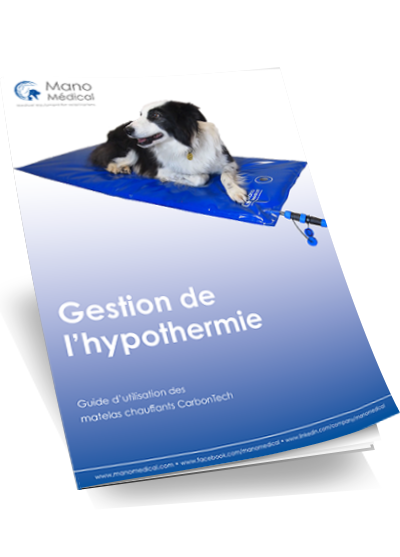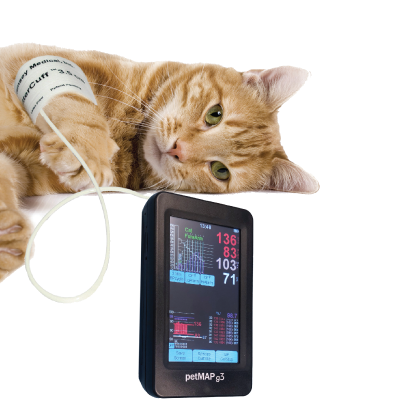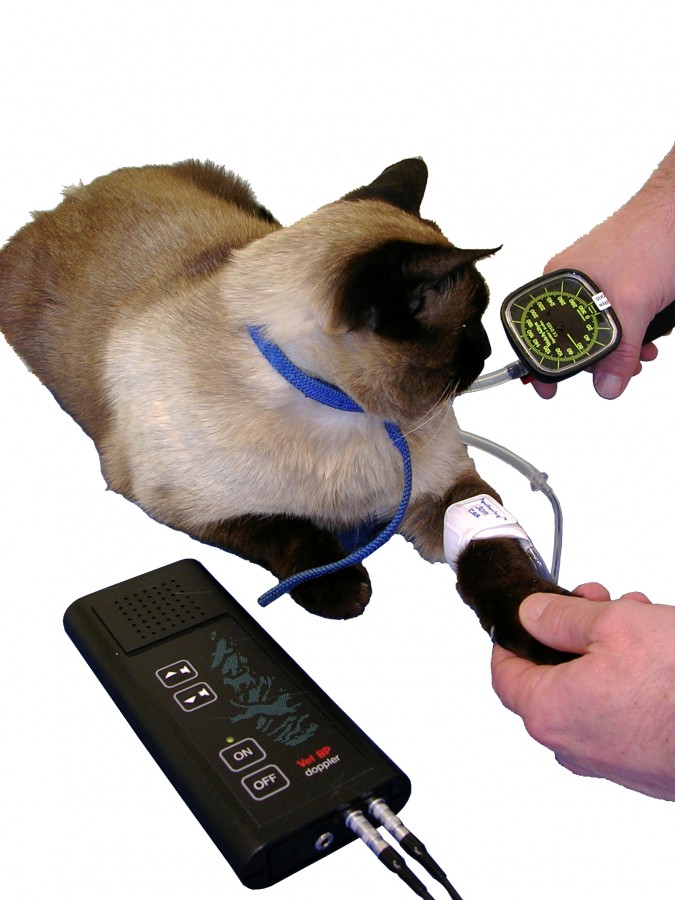Blood pressure: Useful clinical information?
The importance of blood pressure measurement has been underestimated for a long time in veterinary medicine.This examination was considered as complicated on an alert animal.
Knowing the animal blood pressure can be very useful in many different situations:
- Screening high blood pressure in older cats
- Screening pathological High blood pressure in dogs, and cats (cardiology, nephrology, hyperthyroidism, diabetes, etc.)
- Treatment monitoring
- Traumatology (hypotension determination)
- Post-surgical monitoring
- Monitoring of patient during surgery or intensive care
Application: Which method to choose ?
-
Invasive method: A catheter is placed into an artery, allowing a direct blood pressure measurement
-
Non-invasive method (NIBP): The blood pressure is measured indirectly. We put a cuff on one of the patient's limbs, which will be inflated to stop blood flow, then deflated gradually until the pulse is detected. This measurement, and therefore the determination of the systolic, then diastolic pressure can be achieved in three different ways.
-
The doppler method, which converts the pulsation of the artery in an audible signal.
-
By simply detecting the vibrations in the cuff (plethysmographic method)
-
With a device specialized in the analysis of pressure oscillations inside the cuff, which convert them in blood pressure variation while the cuff is deflating progressively (oscillometric method)
Example: PetMAP™, the reference solution in blood pressure measurement, using the oscillometric method.
Blood pressure measurement in 5 minutes!
Advantages and disadvantages of the different methods
 Measurement accuracy and comparison:
Measurement accuracy and comparison:
Several factors affect the measured values, the method used, the measurement site, or even the person taking the measurement.
Even using the invasive method, the measurements will be affected by the diameter of the catheter as well as by the choice of the measurement site : front leg, rear leg, etc...
With the Doppler method, there is a strong dependence on the observer, since the pulse detection is performed by listening.
The oscillometric method has the advantage of being as standardized as possible, but the results obtained on an animal will still depends on the measurement site and the position of the animal.
All these factors mean that in order to make reliable and effective measurements, the measurements must always be taken under the same conditions, and in the case of an animal monitoring, always at the same place
It is also obvious that directly comparing values obtained with different methods and under different conditions is of no interest, unless there was a lot of analytical work performed before.
 Ease of use:
Ease of use:
In clinical routine, non-invasive methods are, of course, the easiest to use.
Using a Doppler, however, can be tricky with an alert animal: you must hold the animal, make sure it stays quiet, manually inflate and deflate the cuff, while listening to the sound produced by the blood flow and monitoring the value on the manometer.
The plethysmographic method is used by global monitoring solutions, therefore necessarily on anesthetized animals.
On alert animals, a dedicated device using the oscillometric method gives the best balance between quality of results and ease of use, if of course it integrates automatic recognition and management of movement artefacts.
 Trick:
Trick:
The display of oscillations in real time (« oscillographic envelop ») makes it easy to recognize movement artefacts but also to know if the measurement conditions are good.
 Cost:
Cost:
A dedicated device using the oscillometric method and incorporating dedicated artifacts correction algorithms, as well as other advanced functions, will inevitably be more expensive than a simple Doppler.
As for a monitoring solution, the cost will depend on the features offered.
In summary:
Doppler:
- Systolic measurement only
- Reliable and inexpensive method but not easy to use
- The standardization of the method is very much dependent on the operator
Oscillometry:
-
It is essential to choose an equipment specific for animals (human medicine devices are unsuitable):
- Need a high sensitivity for the smaller ones (weak oscillation detection)
-
Need an integrated technology to detect motion artifacts: (Step by Step deflation with monitoring of the regular pulsation frequency)
-
Visualization of the oscillometric envelope to ensure that the cuff is correctly positioned, and that the results are calculated on an effective detection of the pulse
-
Short measurement time to avoid stressing the animal
Plethysmography:
Only use in monitoring anesthetized animal. 2 cuff instead of one but the guarantee of reliable measurements even on smaller animals
Choose the method the method that suits the best your veterinary activity!
Discover our blood pressure measurement solutions







